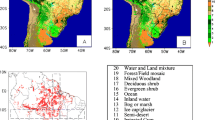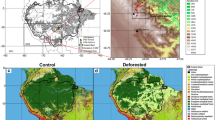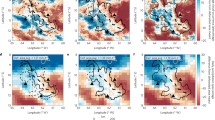Summary
This work evaluates the impact of deforestation on the climate of the eastern portion of the Amazon basin. This region is primarily an area of native tropical rainforest, but also contains several other natural ecosystems such as mangroves and savanna. It is the most densely populated area in Amazonia, and has been significantly affected by deforestation. In this study, numerical simulations were performed with a high spatial resolution, regional model that allows for consideration of mesoscale aspects such as topography, coastlines and large rivers.
To evaluate the present situation and to predict potential future effects of deforestation on the climatic conditions of this region, two, one-year model simulations were made. In the first, “control simulation”, an attempt was made to match the existing surface vegetation. The biophysical parameters used were derived from recent studies of similar Amazon-region ecosystems. In the second run, “deforested simulation”, the forested-area biophysical parameters were replaced by those corresponding to the pasture areas of the region.
The higher-resolution regional modelling revealed important climatic features of the deforestation process, displaying some associated mesoscale effects that are not typically represented in similar Global Circulation Model simulations. Near coastal zones and along large rivers, deforestation resulted in reduced cloud cover and precipitation. However, increased cloud cover and precipitation was predicted over upland areas, especially on slopes facing river valleys. The modelled surface sensible and latent heat fluxes also presented both positive and negative anomalies. The magnitudes of these anomalies were greater during the dry season. Windspeed near the surface was the meteorological variable that presented the most significant change due to deforestation. The reduction in roughness coefficient resulting from the shift from forest to pasture produced increased windspeeds near the Atlantic coast. The greater windspeeds diminished local humidity convergence and consequently reduced rainfall totals in nearby regions.
The results obtained from these higher-resolution simulations show that, in general, orography, coastline profile and the distribution of large rivers play important roles in determining anomaly patterns of precipitation, wind, and energy exchange associated with deforestation in eastern Amazonia.
Similar content being viewed by others
Author information
Authors and Affiliations
Rights and permissions
About this article
Cite this article
Gandu, A., Cohen, J. & de Souza, J. Simulation of deforestation in eastern Amazonia using a high-resolution model. Theor Appl Climatol 78, 123–135 (2004). https://doi.org/10.1007/s00704-004-0048-5
Received:
Revised:
Accepted:
Published:
Issue Date:
DOI: https://doi.org/10.1007/s00704-004-0048-5




